InStep® Corporate Retirement Plan Management
Managing your corporate retirement plan takes planning, people, and process. We built our program to be all three.
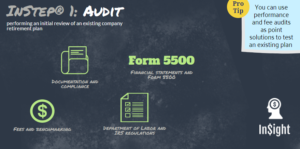
Audit

Organize

Formalize
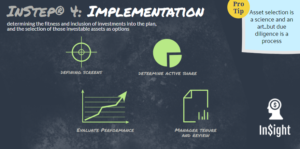
Implementation

Monitor
InStep® is our process for managing the fiduciary liability and the overall success of your corporate retirement plan. It is a 5 step process that takes clients from an initial audit of their performance and policies and helps them build a ecosystem of compliance going forward. Clients that put compliance and transparency at the center of their whole process find themselves in a better legal place and can routinely answer questions in an audit, or for their employees.
Each step of our 5 step process is discussed at length below:
Audit
Our InStep® – Fiduciary Audit will focus on 4 areas: Our Accredited Investment Fiduciary (AIF®) will analyze and conduct a thorough audit to make sure the plan is operating within the guidelines of the plan-related documents. Documents will be reviewed in accordance with fi360’s prudent practice to make sure the financial information is reported correctly and the corporate plan is governed properly. A report will be prepared and delivered to the sponsor and investment committee upon completion.
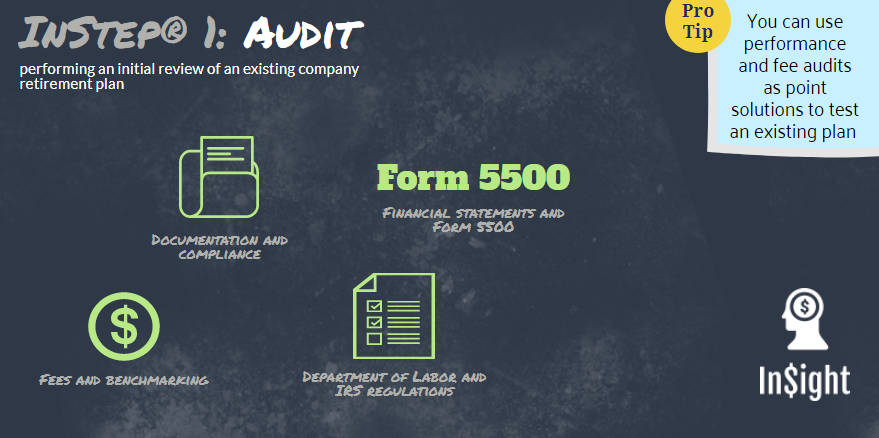
Organize
In the Organize step, we start with education and documentation and reviewing salient parts of the audit. By knowing and following the rules, sponsors and their 401(k) participants expectations are met. Understanding and acknowledging roles, avoiding and if needed, properly managing conflicts of interest and protecting client assets is key from the outset. These are the steps that are included in the Organize step:

Formalize
The Formalize step is where we put the the Investment Policy Statement together. The IPS is the cornerstone of the rest of this program. Having a written, authoritative statement on how you govern the plan will prevent litigation and insulate the sponsor, company, and plan from harm and malfeasance. It is the single most important component to managing a plan. If you don’t have one, run, don’t walk to remedy this.

Implementation
Due diligence and documentation in the implementation stage is critical. In an effort to avoid confusion and contamination, down the road keep the IPS close by and follow the below screens to aid you in the decision making process. These elements will set a minimum acceptable criteria for choosing your investments and the manager.
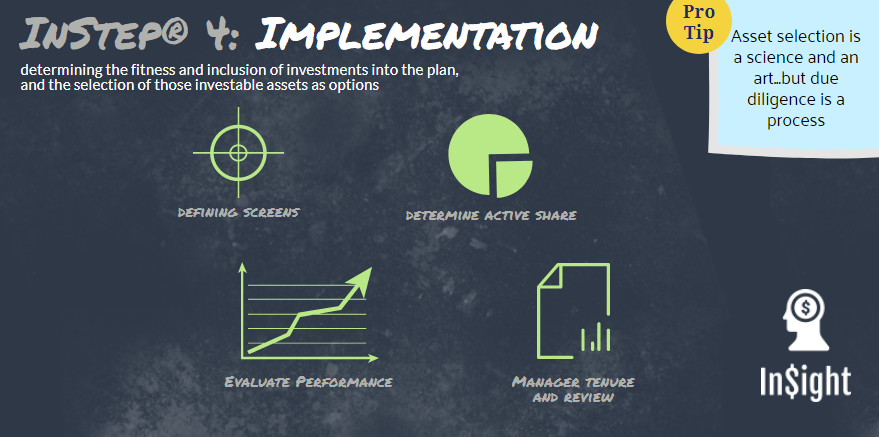
Monitor
The monitor step is the core fiduciary duty you’re responsible for. It’s where incongruence between your governance documents and your actions will cause breaches. This is where most advisors we replace have fallen off, largely because maintenance and monitoring are time consuming and there is no end. Remedies for this complacency include cycling investment committee members (noted in Organize), establishing a cadence for review, and setting priorities. Additionally, outsourcing the monitoring of the underlying assets to a third party advisor helps keep the process in check.
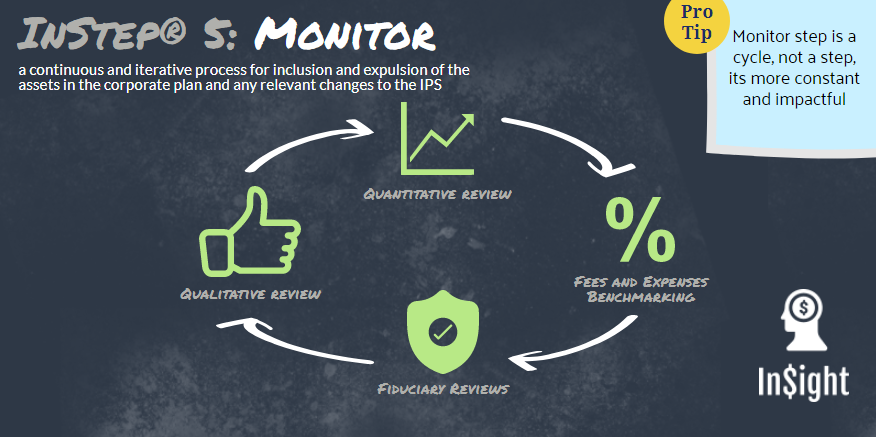
FAQs: Regarding Fiduciary Support in a 401k
Who is the investment manager in my plan?
Typically, the employer assumes the role of Investment Manager. However, in more advanced plans, this role is often delegated to a third-party investment professional or insurance company to enhance legal protection and operational efficiency. Many employers establish investment committees to meet 3(38) fiduciary requirements; however, even in these cases, it’s advisable to work with an AIF® professional to ensure compliance with the Investment Policy Statement (IPS) and Plan Document.
If there is no investment committee, the trustee is obligated to perform these duties. When the 3(38) responsibilities are outsourced, they must be assigned to an RIA firm, bank, or insurance company.
What is the risk of not having a 3(38) fiduciary involved?
The Department of Labor does not mandate the use of a 3(38) Investment Manager; however, audits and recent lawsuits have shown that the risk of not having one can outweigh the cost of engaging these services. Additionally, many companies find that the workload and due diligence required are more efficiently and cost-effectively managed by an external professional.
For HR Executives, CFOs, and Risk Officers, the liability associated with this role—particularly as plan assets grow—is a significant concern. Recent litigation has underscored that much of the accountability for a 401(k) plan’s costs and performance arises from the selection of funds, the due diligence process for choosing them, and vendor selection.
What is covered by a 3(38) fiduciary?
The duties of a 3(38) are set by the Employee Retirement Income Security Act of 1974 (referred to as ERISA) and interpretations and additions regarding the execution of the ERISA law come from the Department of Labor. Further still, a Plan Document can define and clarify additional rules and implementations of the law. So in many cases, a 3(38) fiduciary for a participant-directed plan provides the following on defined intervals:
- Create and manage an Investment Policy Statement
- Form an Investment Committee
- Develop and Enshrine Corporate Plan Governance Notes and Resolutions
- Hold investment committee meetings
- Prudently select plan investment options
- Report on investments regularly
- Benchmark investments
- Replace funds and update models as needed
Should my company have a 3(38) fiduciary?
Beyond simply mitigating risk, outsourcing the investment manager role can significantly lighten an employer’s workload and reduce the overall costs associated with a 401(k) plan. Additionally, experienced investment managers bring specialized tools and expertise that enhance the plan’s efficiency and effectiveness.
A skilled investment manager ensures that fund lineups are cost-efficient, prudent, well-diversified, and competitive, optimizing the plan’s performance for participants.
InStep® Menu of Services and Fee Schedule
| ASSET-BASED FEES | BASED ON PLAN AUM |
|---|---|
| Investment Management Services | 50 BPS |
| Fiduciary Services | 10 BPS |
| SERVICE-BASED FEES | FLAT SERVICE FEE |
|---|---|
| Investment Policy Statement Development | $ 2,000.0 |
| Investment Policy Statement Review/Update | $ 500.00 |
| Plan Design Consulting | $ 2,000.00 |
| Fund Menu Design | $ 1,000.00 |
| Fund Performance Audit | $ 1,000.00 |
| Education Program Strategy | $ 2,000.00 |
| Fiduciary Training for Committee | $ 2,000.00 |
| Group Employee Meetings | $ 1,500.00 |
| One-On-One Employee Meetings | $ 500.00 |
| Other Specialized Committee Training | Varies |
| VENDOR MANAGEMENT SERVICES | FLAT SERVICE FEE |
|---|---|
| Recordkeeper Fee / Service Review or Benchmarking | $ 2,000.00 |
| TPA Vendor Fee / Service Review or Benchmarking | $ 2,000.00 |
| Vendor Management/Issue Resolution | Varies |
| Vendor Search | $ 6,000.00 |
| Vendor Transition Support | $ 4,000.00 |
| Fiduciary Training for Committee | $ 2,000.00 |
| Group Employee Meetings | $ 1,500.00 |
| One-On-One Employee Meetings | $ 500.00 |
| Other Specialized Committee Training | Varies |
| OTHER | |
|---|---|
| Compliance Oversight | Varies |
| Employee Stock Ownership Plan (ESOP) Consulting | Varies |
| HSA Consulting | Varies |
